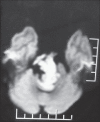Intrinsic brainstem white epidermoid cyst: An unusual case report
- PMID: 24891906
- PMCID: PMC4040035
- DOI: 10.4103/1817-1745.131487
Intrinsic brainstem white epidermoid cyst: An unusual case report
Abstract
Epidermoid cysts involving the brainstem are extremely rare, with only 18 reported cases in the literature and only five purely intrinsic epidermoid cysts within this group. "White epidermoids", a rare entity, have high protein content and show reversed signal intensity on magnetic resonance images. In contrast to the classical variety, these cysts show high signal intensity on T1-weighted images and low signal intensity on T2-weighted images. Here, we report an interesting case of intrinsic brainstem "white epidermoid cyst" in a 15-year-old girl and discuss its clinical characteristics, radiological features, and surgical treatment. The girl presented with a one-year history of progressive quadriparesis, and features of multiple cranial nerve involvement. Because the cyst was purely intrinsic and had altered signal intensity, the diagnosis was initially unclear until definitive neuroimaging was performed using diffusion-weighted magnetic resonance imaging (DW-MRI) sequences.
Keywords: Brainstem; epidermoid cysts; intrinsic; white.
Conflict of interest statement
Figures



Similar articles
-
Intracranial progression of the epidermoid cyst to a white epidermoid cyst in a pediatric patient: a case report.J Med Case Rep. 2023 Nov 29;17(1):495. doi: 10.1186/s13256-023-04243-y. J Med Case Rep. 2023. PMID: 38017508 Free PMC article.
-
Intrinsic brainstem epidermoid cyst. Case report and review of the literature.J Neurosurg. 2006 Apr;104(4 Suppl):285-9. doi: 10.3171/ped.2006.104.4.285. J Neurosurg. 2006. PMID: 16619643 Review.
-
White epidermoid cyst of brainstem.BMJ Case Rep. 2024 Dec 15;17(12):e262713. doi: 10.1136/bcr-2024-262713. BMJ Case Rep. 2024. PMID: 39675805
-
Brainstem epidermoid cyst: An update.Asian J Neurosurg. 2016 Jul-Sep;11(3):194-200. doi: 10.4103/1793-5482.145163. Asian J Neurosurg. 2016. PMID: 27366244 Free PMC article. Review.
-
Correlation of radiological features of white epidermoid cysts with histopathological findings.Sci Rep. 2022 Feb 10;12(1):2314. doi: 10.1038/s41598-022-06167-x. Sci Rep. 2022. PMID: 35145173 Free PMC article.
Cited by
-
Intracranial progression of the epidermoid cyst to a white epidermoid cyst in a pediatric patient: a case report.J Med Case Rep. 2023 Nov 29;17(1):495. doi: 10.1186/s13256-023-04243-y. J Med Case Rep. 2023. PMID: 38017508 Free PMC article.
-
Fat in the brain: Facts and features.Neuroradiol J. 2024 Oct;37(5):531-545. doi: 10.1177/19714009221150848. Epub 2023 Jan 7. Neuroradiol J. 2024. PMID: 36609194 Review.
-
Intrinsic epidermoid of the brain stem: case report and review of the literature.Childs Nerv Syst. 2018 Aug;34(8):1589-1592. doi: 10.1007/s00381-018-3774-1. Epub 2018 Mar 19. Childs Nerv Syst. 2018. PMID: 29556696 Review.
-
Parasellar epidermoid cyst with unique radiological features: A case report and review of the literature.Radiol Case Rep. 2023 Feb 17;18(4):1628-1632. doi: 10.1016/j.radcr.2023.01.073. eCollection 2023 Apr. Radiol Case Rep. 2023. PMID: 36865620 Free PMC article.
-
Spontaneous regression of white epidermoid cyst of the pre-bulbar cistern in a 3-year-old child: a case report and literature review.Childs Nerv Syst. 2023 Nov;39(11):3065-3070. doi: 10.1007/s00381-023-06140-7. Epub 2023 Sep 5. Childs Nerv Syst. 2023. PMID: 37668670 Review.
References
-
- Katzman GL. Diagnostic Imaging: Brain. Salt Lake City, Utah: Amirsys; 2004. Epidermoid cyst; p. I-7-16.
-
- Recinos PF, Roonprapunt C, Jallo GI. Intrinsic brainstem epidermoid cyst. Case report and review of the literature. J Neurosurg. 2006;104(Suppl 4):285–9. - PubMed
-
- Berger MS, Wilson CB. Epidermoid cysts of the posterior fossa. J Neurosurg. 1985;62:214–9. - PubMed
-
- Cobbs CS, Pitts LH, Wilson CB. Epidermoid and dermoid cysts of the posterior fossa. Clin Neurosurg. 1997;44:511–28. - PubMed
-
- Toglia JU, Netsky MG, Alexander E., Jr Epithelial (epidermoid) tumors of the cranium. Their common nature and pathogenesis. J Neurosurg. 1965;23:384–93. - PubMed
Publication types
LinkOut - more resources
Full Text Sources
Other Literature Sources

